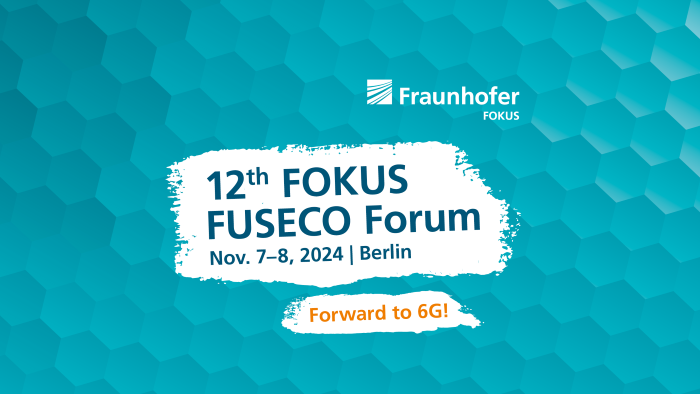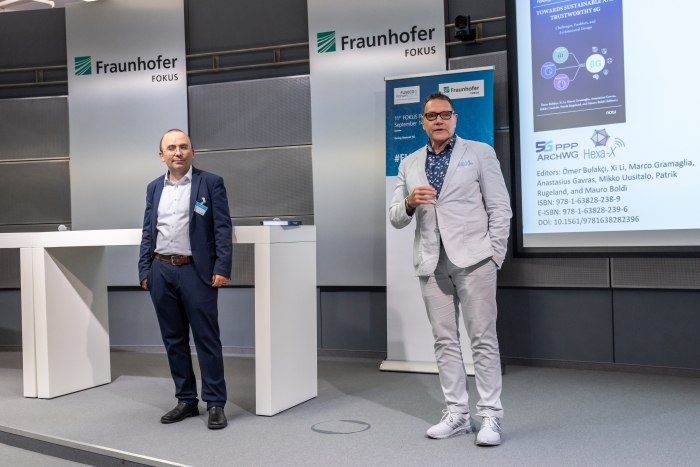ESA showcases German space-enabled 6G connectivity capabilities

ESA is a key driver of 5G and 6G technologies, with 6G technologies still in the middle of their research and development and pre-standardisation phases. These challenges and opportunities will be shared by ESA’s Space for 5G/6G and Sustainable Connectivity strategic programme line at the 12th FOKUS FUSECO Forum in Berlin, hosted by Fraunhofer FOKUS (Institute for Open Communication Systems).
ESA is showcasing two of its leading funded testbeds at the conference. Non-terrestrial networks (NTNs) feature as one of the key topics of the FOKUS FUSECO with the participation of experts from satellite, terrestrial and verticals representatives.
ESA’s Space for 5G/6G & Sustainable Connectivity is overseen by ESA's Connectivity and Secure Communications directorate within the Advanced Research in Telecommunications Systems (ARTES) programme. ESA’s Senior 5G/6G Satellite Solutions Architect, Maria Guta, will be in Berlin sharing how ESA is driving space-enabled 5G and future 6G technologies in Europe, ensuring it maintains technological leadership in an increasingly globally competitive market.
In its role as an internationally recognised industry-oriented event, the FUSECO Forum mirrors the lessons learned from global public and private 5G network deployments and research and standardisation. Similarly, the industry is witnessing increasing interest in private industrial campus network deployments and industries which are preparing for the 6G age.

As a key sponsor of the event, ESA will showcase live demonstrations of its 5GEOSiS and 6G SmartSAT projects, both led by Eurescom GmbH, on 7 and 8 November.
5GEOSiS works with a German consortium led by Eurescom GmbH, subcontracted by Fraunhofer FOKUS and Airbus Defence and Space GmbH. The project is developing a 5G Repurposeable Payload, which will provide a processor for 5G and beyond 5G NTN use cases to be repurposed for a wide range of (and growing) Earth observation.
6G SmartSAT is also managed by a German consortium, led again by Eurescom GmbH, supported by subcontractors Fraunhofer FOKUS, Airbus Defence and Space GmbH, and Deutsche Telekom. It aims to provide a first-of-its-kind toolset to investigate and develop solutions for future 5G/6G networking architectures for multi-layered NTNs.
These demonstrations will form the backdrop of discussions, covering the new momentum being built on international standardisation and growing new ecosystems towards 6G. These ecosystems are benefiting the innovating fields of Open Radio Access Network, sub–Terra Hertz Radio Systems, NTNs, Network Automation, Artificial Intelligence/ Machine Learning, Open Source Toolkits, as well as new envisaged 6G use cases demanding a critical assessment of emerging 6G technologies and architectures.

Maria Guta, who will be presenting an overview of ESA initiatives at the “3rd Euro NTN Workshop: TN NTN Unification, Non-Terrestrial Networks in the 6G Era - Current Topics and Latest Advancements" session, on 7 November, and on the "6G for All" panel on 8 November, said: “The team looks forward to demonstrating how ESA NTN initiatives are driving Europe as a leader in showcasing space-enabled European connectivity, we’re proud to sponsor and demonstrate the innovative technologies our partners are building under the ARTES programme.”
The Space for 5G/6G & Sustainable Connectivity strategic programme line is working to bring together the native integration of terrestrial and NTN, which will revolutionise how we live, work and communicate in terms of smart mobility, global coverage, security and network resilience. Additionally, the programme aims to promote the standardisation of seamless global connectivity for various industries and applications, including telemedicine, tele-education, and autonomous vehicles, airplanes and ships.


